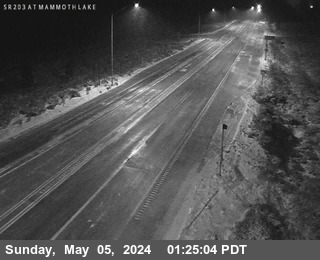Brought to you by Howard Sheckter
Upper Ridge in the mean anchored over the Far West to keep a persistent Dry Cold pattern in place for California……Split Flow Pattern for the Rest of the Country….
Wednesday January 2, 2013
Thursday Am Post:
Not as chilly yesterday with a strong inversion setting up. Highs popped to the upper 30s and low 40s while valleys continued in the deep freeze down into the teens and 20s. In January when this occurs…the true “Banana Belt” within the Mammoth Eastern Sierra is about from 7800 Feet to Canyon Lodge….Usually not the Trails and absolutely not the Crowley Lake lower subdivisions, as they both are commonly below the inversion and thus colder!
The temperature inversion is expected to remain in place for another 48 hours then possibly weaken a bit over the weekend as today’s more progressive model solution in the eastern pacific takes a weakening short wave through the upper ridge Sunday into Early Monday. This may allow some snow showers or light snowfall for a time Sunday. Will update in this the next few day to see how and if it holds together.
Otherwise the next change in the pattern is expected occur about a week away next Thursday as the eastern pacific ridge retrogrades to about 140ish and a cold arctic air-mass invades the Midwest. Potentially…..This will bring some of the coldest weather to the Midwest in several years. Typically this is still considered a drier than normal pattern for the Eastern Sierra. Some light snow is still possible. The return of wet weather to the Sierra is discussed in yesterdays discussion.
_____________________________________________________________________________________________________________________________________________
Note:
Some clarification to yesterdays post at the end of the Longer range:
—————————————————————————————-
Yes its chilly!…..The high was 30 at the Village yesterday, 9 degrees this AM. However, nothing compared to Bridgeport with lows again near -20F for the 3rd straight morning! This time of the year when the sun is at its lowest angle and you have snow cover in place as well as sinking air, it can get very cold. There is no real mechanism to flush out the cold until the weekend.
The weather pattern over the CONUS is split-flow. The short waves coming toward the coast are being effected by the far western upper ridge. These systems are splitting with the northern branch the strongest, diving SE out of Canada, with then a weak southern branch coming out of northern Baja, Mx.
At the moment there is a REX Block over our state with a small upper low just off the northern Baja Coast near Ensenada. At the surface, a 1044mb high is located over SE, Oregon with light easterly flow at the surface from Nevada. By Friday the upper low to the south of us kicks east into New Mexico while we stay ridged up. Air Quality will slowly diminish especially Thursday into Friday and possibly through Saturday.
Since any significant snowfall is pretty much out of the question for a week, the interests will focus upon Air Quality for the Eastern Sierra as well as temps.
The Models:
1. 12z GFS has the next upstream system splitting with another southern branch short wave cutting off and effecting Southern Ca before it heads east. We may get some easterly flow from that system.
2. 00z ECMWF has the system splitting further offshore with a more slower solution and more ridging for the Eastern Sierra. This is probably the worst case for air quality and the strongest inversions.
3. 12Z GEM has the short wave more progressive as it comes through California with enough wind and UVM to flush out whatever….and even a dusting of snow. However, like most cases, the (GEM) Canadian model does a poor job for the west coast for some reason and is discounted.
The UKMET was initialized poorly showing an upper low over Northern Ca this morning. The models guidance was thrown out.
Longer range:
The GFS for the past 2 runs has been showing some retrogression and amplification for the Eastern Pacific Ridge. It sets the stage for some serious Arctic Air to penetrate deep into the Mid west via Montana. No doubt that some of this “Thick Soup” will break west of the divide and so another shot of cold will likely flush through the Eastern Sierra between the 10th and the 15 inside “Gangnam Style”.
LONGEST RANGE THINKING:
The Dweebs checked the weekly CPC discussion on the MJO. It appears that the MJO is in phase 3 and is expected to remain weak to moderate as it progresses to phase 5. So, extra-tropical impacts of the MJO may become more prevalent over the next couple of weeks as the diabatic heating serves as source for downstream Rossby wave propagation.
The seeds for this interaction are seen in recent 200-mb zonal wind anomalies, which nearly match the canonical composites associated with phases 3 and 4. The result is; a retraction of the jet across Asia and positive height anomalies downstream south of the Aleutians. This could translate to positive height anomalies across eastern North America. The latest extended range forecast is in agreement with this scenario toward the middle of January. Should the MJO bring enhanced convection into the Western Pacific and subsidence into the Indian Ocean, the opposite forcing would occur, with the MJO forcing an extension of the East Asian jet and a downstream pattern reversal over North America by the end of the month…..”Bringing wet weather back to the Sierra“.




